Are you wondering, what rabbit breed is best for me? If so, read our guide to some of the most popular rabbit breeds including the English Lop, Netherland Dwarf, Dutch rabbit and other popular breeds.
According to the British Rabbit Council, there are more than 50 recognised breeds of rabbit in the UK. It’s worth doing your research before choosing the perfect rabbit breed for you, as each has their own personality, characteristics and needs.
What rabbit breed is best for me?
Depending on their breed, rabbits can vary in their appearance, care requirements and life expectancy, as well as in their vulnerability to specific health conditions. For example, brachycephalic (flat-faced) rabbit breeds have misaligned jaws and are therefore more likely to suffer from overgrown teeth and painful dental conditions. Due to their shallow eye sockets, they are also more likely to have abnormal tear production, resulting in weepy eyes.
Lop-eared rabbits (rabbits with floppy ears) are predisposed to ear infections due to the build-up of wax in their outer ear fold and deafness due to their narrow ear canals. The shape of their skulls also makes them more prone to dental and eye problems.
Long-haired breeds are for the dedicated owner, as you’ll need to spend a lot of time grooming them. Larger rabbit breeds are generally more laid-back and less excitable than smaller breeds, but typically the lifespan of these rabbits is shorter than their smaller counterparts.
Here are some of the most popular rabbit breeds in the UK. Find out what you need to know about their appearance, lifespan and temperament.
Angora
Known for its fluffy, thick coat of soft hair, these medium-sized rabbits weigh around 2-3kg. Perfect as a pet due to their gentle nature and sociability, Angoras typically come in white, grey and gold.
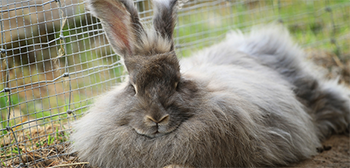
Their coats need regular grooming and should also be clipped a few times each year to keep them healthy and prevent matting, which can lead to skin infections and put them at heightened risk of fly strike. They are also particularly prone to gastric and intestinal stasis as a result of ingesting excess fur.
Living between five and eight years, Angora rabbits are affectionate and playful. Care should be taken when considering this breed, however, as they don’t like being handled. Not only can they become scared and aggressive if handled, but their spines can be easily damaged. Make sure your Angora is covered with insurance so that you can get your pet the best care should they need it.
Dutch
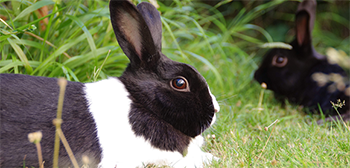
Perfect as a family pet, especially if you have young children, these rabbits originate from the UK – despite their name. The Dutch rabbit is a small- to medium-sized breed, weighing around 2kg with short, shiny fur that comes in a distinctive pattern. The ears and side of the face, plus the abdomen, are coloured (black, grey, or shades of brown), and the rest of the body is white.
Living five to eight years, Dutch rabbits welcome play and toys, need little grooming and can be easily trained. If you are looking for a family pet, remember that children should be supervised around animals at all times, to make sure everyone stays safe and happy.
Dwarf Lop
These rabbits are small to medium size and come in a wide range of colours including fawns, orange and black sable. They can be solid-coloured or have patches of white.
Dwarf Lops are laid back and very loving and outgoing, with a cheery disposition. Be aware, however, that unneutered males will molest shoes, feet and toys and some females can be bad-tempered until they are spayed. This breed tends to live for five to eight years.
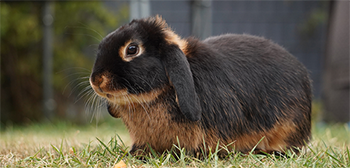
Dwarf Lops make great house rabbits as they can be easily trained and are fine with being handled and cuddled. As a lop-eared breed, they are prone to dental problems, such as front teeth malocclusion, and eye conditions, however. Factor this into your budget and make sure you cover your pet rabbit with insurance.
English Lop
One of the oldest domestic rabbit breeds, English Lops are also known as ‘the king of the fancy’ and are immediately recognisable thanks to their long, floppy ears.
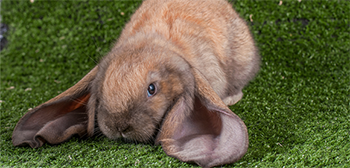
A friendly and calm pet, English Lops live for five to seven years and are popular as show rabbits. They are large, weigh around 5kg and are low-maintenance, with a placid and intelligent nature. English Lops need little grooming as they have short fur that snaps back into position when stroked. Colours include white, black, fawn and gold in a solid colour or with patches.
If you are considering an English Lop, be aware that they face the same health risks as other Lops and that they are prone to becoming overweight. They’re less able to exercise easily because of their ears and they tend to overeat. They can also get very cold – again, due to the size of their ears – so are best kept indoors.
Jersey Wooly
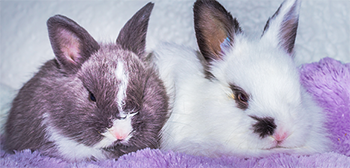
A small rabbit weighing only around 1.5kg, the Jersey Wooly is a gentle, loving and playful animal that makes a good first pet for children. Just ensure that children are well-versed on gentle play and always supervise interactions between children and their pets.
Jersey Wooly rabbits are perfect for keeping indoors and while they love cuddles and play they do also need plenty of exercise space. A cross between the French Angora and the Netherlands Dwarf, this breed lives around seven to 10 years. They have a woolly, soft coat that needs de-tangling once a week for most of the year, and more often when they are shedding hair in the spring. Jersey Wooly rabbits are prone to dental problems as a result of teeth misalignment caused by their small heads and comparatively long jaws.
Himalayan
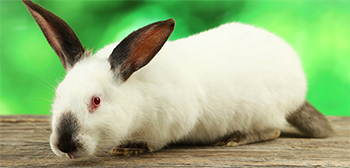
Easily identifiable with distinct markings, Himalayan rabbits have red eyes and white fur with dark markings on the ears, nose, tail and paws. A medium-sized bunny that can live inside or outdoors, Himalayan rabbits live for around 10 years and have short coats requiring minimal grooming. Their cylindrical body shape allows them to squeeze into very tight spaces – something to bear in mind if you’re looking for a house rabbit! Calm, friendly and intelligent, Himalayan rabbits love being with people and can be very affectionate.
Miniature Lop (Holland Lop)
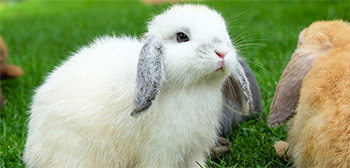
The Miniature Lop – also known as the Mini Lop – is a medium-sized rabbit weighing around 2.5kg. It is called the Holland Lop in the USA. These rabbits are friendly and just love to play with items like cat toys. Mini Lops are full of fun and energy, though they are best in quieter environments and not necessarily suited to homes with younger children.
Living up to 10 years, Mini Lops are easy to care for. Yet they need regular grooming due to their dense, mid-length fur. They come in solid colours such as cream, fawn, chestnut and black, although they may have patches of another colour on top. Mini Lops need plenty of time out in the open air, so you’ll need to have a large hutch and run, plus a selection of toys to play with. Like other Lop breeds, Mini Lops are prone to dental, ear and eye problems.
Lionhead
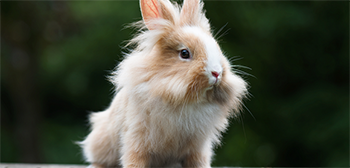
With a lifespan of seven to nine years, this breed of rabbit is known for the fluffy mane that gives them their name. This unique mane is due to a genetic mutation and can be either a single mane around their head and ears only, or a double mane that covers most of their bodies. It is important to be aware, however, that Lionheads are a brachycephalic breed, which means they are more prone to health conditions, such as overgrown teeth.
Lionhead rabbits are popular as both show rabbits and pets. While they usually have a calm, friendly nature, they can be aggressive when frightened and are not suitable as pets for young children. Weighing just under 1.5kg these small rabbits need lots of care and grooming. Colours include chestnut, black, blue and lilac.
Netherland Dwarf
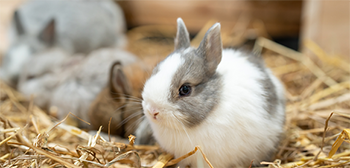
This breed is positively tiny (usually weighing less than a kilogram) – and, for this reason, tends to be considered as cute. Nevertheless, Netherland Dwarfs are a brachycephalic breed, with the associated health problems that brings. They have a compact body, short neck and a broad head with a rounded face. They can be nervous and feisty, so may not be the best option for a household with young children. Building a bond with them takes time, but with regular, careful handling they enjoy human companionship. Their life span is typically seven to 10 years.
New Zealand White
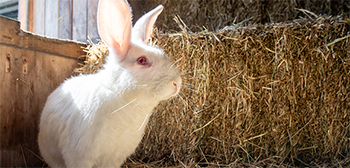
Despite its name, the New Zealand White breed was developed in the USA to be a distinctively big (typically 4.5 to 5.5kg) and slender rabbit with a muscular face, round cheeks and long ears that stand up straight. Their friendly and placid disposition makes them good pets for kids, with the added bonus that they love being handled. As with the other breeds we’ve listed, make sure children understand how to handle rabbits and always supervise playtime.
With eyes that vary from pale pink to ruby purple, New Zealand White rabbits have fluffy, thick fur that’s prone to moulting and requires weekly grooming. New Zealand White rabbits live between five and eight years on average, and can be kept indoors or outside.
Sussex
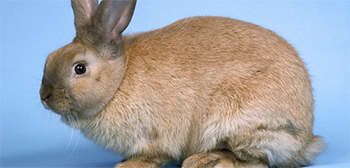
With teddy-bear features and a very lovable personality, it’s easy to see why Sussex rabbits are such a popular breed. They’re friendly and outgoing and come in a variety of colours, including gold and creams.
Living around six to eight years, Sussex rabbits are medium to large-sized bunnies – big enough to coexist with other pets such as cats and dogs, provided the right introductions take place. Bear in mind some breeds of dog have high prey drives and may be less suited to life with smaller pets.
Sussex rabbits make excellent house rabbits as they love human interaction. They can be quite greedy, however, so care needs to be taken with their diet. Their thick coat needs a brush at least once a week.
Are you a bunny owner? What tips would you give to others who are trying to decide the best breed of rabbit as a pet? Share your thoughts with us on social media using #PethoodStories.
